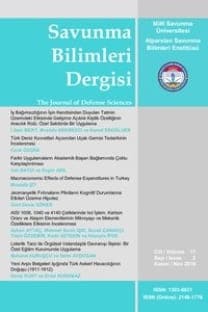Yapay zeka uygulamalarında kullanılan arama algoritmalarının kıyaslanması
Comparing search algorithms in used artificial intelligence application
___
- Bellman, R.E., Dreyfus, S.E. 1962. "Applied Dynamic Programming." Princeton, NJ: Princeton University Press.
- Benzer, R., "Zeki Karar Sistemleri ve Bazı Askeri Uygulamaları", Yüksek Lisans Tezi , Sakarya Üniversitesi Fen Bilimleri Enstitüsü, Sakarya, (1998).
- D. J. Slate and L. R. Atkin. Chess 4.5-the northwestern university chess program. In P. W. Frey, editör, Chess Skill in Man and Machine, 82- 118. Springer-Verlag, 1977.
- D. Ratner & M. Warmuth, "Finding a shortest solution for the NxN extension of the 15-puzzle is intractable", Proceedings of AAAI 1986, Philadelphia, Pa, 1986.
- Dijkstra, E. 1959. A note on two problems in connexion with graphs. Numerische Mathe-matik 1:269-271.
- Doran, J., & Michie, D. Experiments with the Graph-Traverser Program. Proc. Roy. Soc, 1966, A,, 235-259.
- Dreyfus, S. (1969) 'An appraisal of some shortest path algorithms', Operations Research, Vol. 17, pp.395-412.
- Erdmann, M. A. and Mason, M. T. (1988). An exploration of sensorless manipulation. IEEE J. of Robotics and Automation, 4(4):369-379.
- G.Gallo and S. Pallottino "Shortest path algorithms" Annals of Operations Research 13, p.3-79,1988.
- Genesereth, M., and Nourbakhsh, I. 1993. Time-saving tips for problem solving with incomplete information. Proceedings of the National Conference on Artificial Intelligence, 724-730.
- George P., "How to solve it: A new aspect of mathematical method", Princeton University Press, Princeton, NJ: 194, 204 pages.
- Hart, P.; Nilsson, N.; and Raphael, B. 1968. A formal basis for the heuristic determination of minimum cost paths. IEEE Trans. Systems Science and Cybernetics SSC-4(2):100-107.
- Kalaycı, T. E., "Yapay zeka teknikleri kullanan üç boyutlu grafik yazılımları için "extensible 3d" (x3d)ile bir altyapı oluşturulması ve gerçekleştirimi", Yüksek Lisans Tezi, Ege Üniversitesi Fen Bilimleri Enstitüsü, İzmir, (2006).
- Koenig, S. and Simmons, R.G. 1998. Solving robot navigation problems with initial pose uncertainty using realtime heuristic search. Proceedings of the International Conference on Artificial Intelligence Planning Systems.
- Korf, R. 1985. Depth-first iterative-deepening: An optimal admissible tree search. Artificial Intelligence 27(1 ):97-109.
- Loyd, S. Mathematical Puzzles of Sam Loyd, Vol. 1. New York: Dover, pp. 19-20, 1959.
- Moore, G. E., 1959, Philosophical Papers, Allen & Unwin, London.
- N. Deo and C. Pang. Shortest path algorithms: taxonomy and annotation. Networks, 14:257-323,1984.
- Newell, Allen, Shaw, Christopher J., Simon, A. H., "Preliminary description of general problem solving program - I GPS-1" Pittsburgh, Pa.: Graduate School of Industrial Administration, Carnegie Inst. of Technology 1957. (CIP Working Paper. No. 7.).
- Newell, A., Shaw, J.C., and Simon, H.A. (1958). Chess playing programs and the problem, of complexity. IBM Journal of Research and Development, October 2, pp. 320-335. Reprinted in Computers and Thought (eds. E.A. Feigenbaumand J. Feldman), 39-70, McGraw-Hill Book Company, NewYork.
- Özdamar, K., "Paket Programlar ile İstatistiksel Veri Analizi", Kaan Kitabevi, Eskişehir, 381 -382 (2002).
- Pohl, I. (1971). Bi-directional search. In Machine Intelligence 6, pp. 127-140 Edinburgh. Edinburgh University Press.
- R. Dechter and J. Pearl, Generalized best-first strategy and the optimality of A*, JACM, 32(3)505-536, 1985.
- Reinefeld, A., "Complete Solution of the Eight-Puzzle and the Benefit of Node Ordering in IDA*", IJCAI-93. Proceedings of the Thirteenth International Joint Conference on Artifjcial Intelligence, San Mateo, CA, USA: Morgan Kaufmann Publishers, 248-253 (1993).
- Ruml, W., "Real-time Heuristic Search for Combinatorial Optimization and Constraint Satisfaction", Harvard University, (2002).
- Schaeffer,J. "Heuristic Search", http://www .cs.ualberta.ca /-Jonathan /Courses/657/Notes/1 .lntroduction.pdf, (2004).
- Schofield, K., 1967, 'An evaluation of kinetic rate data for reactions of neutrals of atmospheric interest,' Planet Space Sci., 15, pp. 643-670.
- Weixiong, Z.," State-Space Search", Springer Publisher, 1-3 (1999).
- Zhou, R., and Hansen, E. 2002. Multiple sequence alignment using A*. Proceedings of the National Conference on Artificial Intelligence (AAAI).
- ISSN: 1303-6831
- Yayın Aralığı: 2
- Başlangıç: 2002
- Yayıncı: Milli Savunma Üniversitesi Alparslan Savunma Bilimleri ve Millî Güvenlik Enstitüsü
Yapay zeka uygulamalarında kullanılan arama algoritmalarının kıyaslanması
Ali İhsan BENZER, Benian TEKİNDAL, Recep BENZER
Improvements of Some Characteristics for Optical Thin Films with Ion-Assisted Deposition
YAPAY ZEKÂ UYGULAMALARINDA KULLANILAN ARAMA ALGORİTMALARININ KIYASLANMASI
Benian TEKİNDAL, Recep BENZER, Ali İhsan BENZER
Kurumsal Yönetim-Şirket Performansı İlişkisi: Kuramsal Bir Analiz
Cem Harun MEYDAN, H. Nejat BASIM
Emel Kızılkaya AYDOĞAN, Cevriye GENCER
21.Yüzyıl için ABD Güvenlik Politikası ve Büyük Orta Doğu Girişimi
